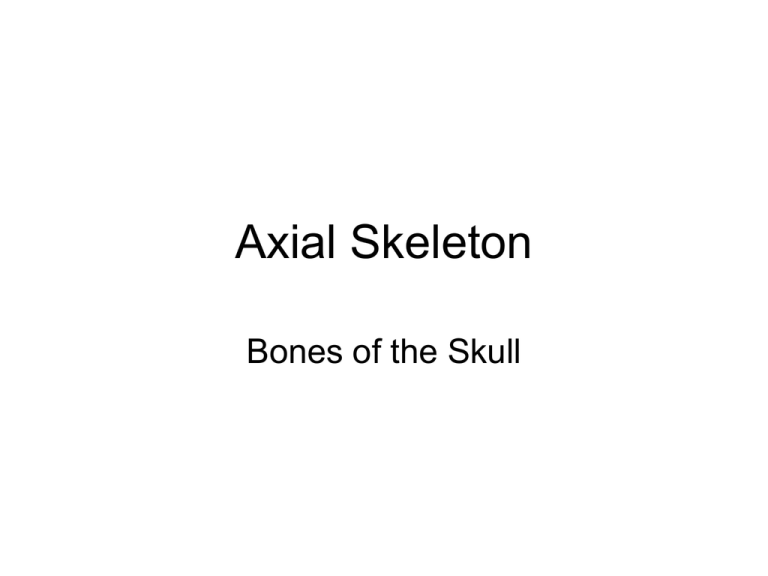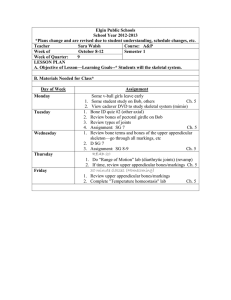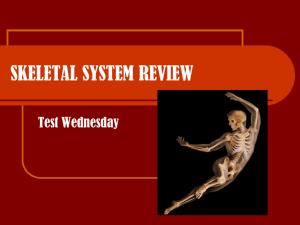Axial Skeleton - The Skull
advertisement

Axial Skeleton Bones of the Skull The Skull: Two Sets of Bones • The Cranium: • Facial: Cranium = 3 Sutures Three Sutures • Coronal • Sagittal • Lamboidal Cranium = 8 Bones • • • • • • Frontal = 1 Parietal = 2 Temporal = 2 Occipital = 1 Sphenoid = 1 Ethmoid = 1 Frontal = #1(single) Parietal = #2 (Pair) Temporal = #4 (pair) Bone Markings of the Temporal Bone External Acoustic Meatus • Canal that leads to the eardrum Bone Markings of the Temporal Bone Styloid Process • Needle-like projection • The site of muscle attachment for many neck muscles Bone Markings of the Temporal Bone Zygomatic Arch • The bridge that joins with the cheek bone Bone Markings of the Temporal Bone Mastoid Process Rough projection posterior and inferior to the acoustic meatus Filled with air cavaties called mastoid sinuses Attachment site for neck muscles Bone Markings of the Temporal Bone • Openings: • Jugular Foramen • Carotid Canal Occipital = #3 (single) Bone Markings of the Occipital Bone • Foramen Magnum • Large opening that allows the spinal cord to connect with the brain Bone Markings of the Occipital Bone • Occipital Condyles • Rest on the first vertebra of the spinal column Sphenoid • Butterfly shaped, spans the width of the skull Markings of the Sphenoid • Stella Turcica: “Turk’s Saddle” that holds the pituitary gland • Foramen Ovale: Oval opening that allows Cranial Nerve V to pass to the chewing muscle Ethmoid Features of the Ethmoid • Crista Galli: “Cock’s Comb” where the brain covering attaches • Cribiform Plate: Nerves carrying olfactory receptors Extensions of Ethmoid Bone • Superior and Middle Nasal Conchae • Form lateral walls of the nasal cavity Facial Bones • • • • • • • Maxillae (2 Fused) Palatine (Paired) Zygomatic Lacrimal Nasal Vomer Inferior Nasal Conchae • Mandible Maxillae • Upper Jaw • All facial bones except the mandible join the maxillae • Carry the upper teeth Palatine Bones • Paired bones form the posterior part of the hard palate Zygomatic Bones • The cheekbones • Form the eye sockets Lacrimal Bones • Medial walls of the orbit (eye socket) with a groove for tears (lacrima = tear) Nasal Bones = #4 Vomer Bone Inferior Nasal Conchae Mandible Hyoid Bone • Not included with skull • Closely related to the mandible • Does not articulate (suspended) • Base for tongue movement • Attachment for neck muscles • Not the Adam’s Apple, that is the thyroid cartilage surrounding the larynx






